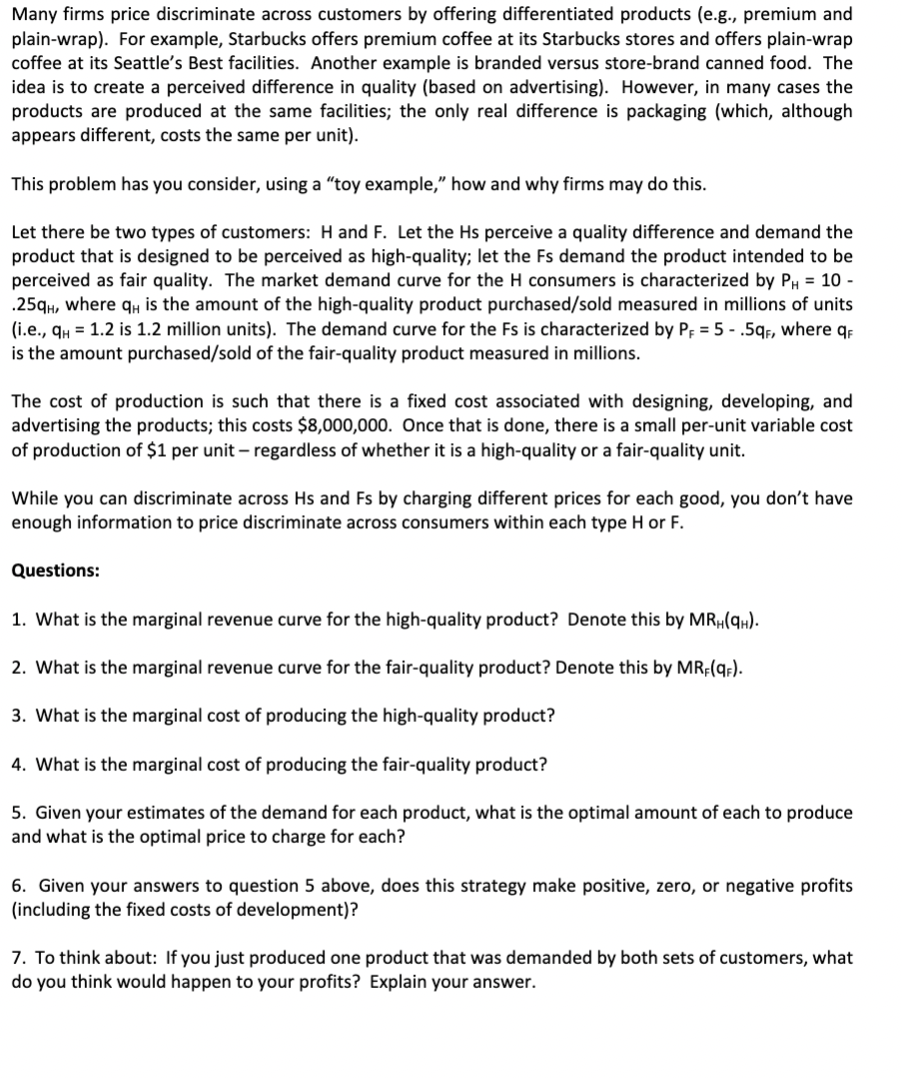3. What is the marginal cost of producing the high-quality product? 4. What is the marginal cost of producing the fair-quality product? 5. Given your estimates of the demand for each product, what is the optimal amount of each to produce and what is the optimal price to charge for each? 6. Given your answers to question 5 above, does this strategy make positive, zero, or negative profits (including the fixed costs of development)? 7. To think about: If you just produced one product that was demanded by both sets of customers, what do you think would happen to your profits? Explain your answer.
3. What is the marginal cost of producing the high-quality product? 4. What is the marginal cost of producing the fair-quality product? 5. Given your estimates of the demand for each product, what is the optimal amount of each to produce and what is the optimal price to charge for each? 6. Given your answers to question 5 above, does this strategy make positive, zero, or negative profits (including the fixed costs of development)? 7. To think about: If you just produced one product that was demanded by both sets of customers, what do you think would happen to your profits? Explain your answer.
Chapter7: Uncertainty
Section: Chapter Questions
Problem 7.15P
Related questions
Question
1 and 2 done, need the rest

Transcribed Image Text:Many firms price discriminate across customers by offering differentiated products (e.g., premium and
plain-wrap). For example, Starbucks offers premium coffee at its Starbucks stores and offers plain-wrap
coffee at its Seattle's Best facilities. Another example is branded versus store-brand canned food. The
idea is to create a perceived difference in quality (based on advertising). However, in many cases the
products are produced at the same facilities; the only real difference is packaging (which, although
appears different, costs the same per unit).
This problem has you consider, using a "toy example," how and why firms may do this.
Let there be two types of customers: H and F. Let the Hs perceive a quality difference and demand the
product that is designed to be perceived as high-quality; let the Fs demand the product intended to be
perceived as fair quality. The market demand curve for the H consumers is characterized by PH = 10 -
.25qH, where qH is the amount of the high-quality product purchased/sold measured in millions of units
(i.e., qy = 1.2 is 1.2 million units). The demand curve for the Fs is characterized by P; = 5 - .5gr, where q
is the amount purchased/sold of the fair-quality product measured in millions.
The cost of production is such that there is a fixed cost associated with designing, developing, and
advertising the products; this costs $8,000,000. Once that is done, there is a small per-unit variable cost
of production of $1 per unit – regardless of whether it is a high-quality or a fair-quality unit.
While you can discriminate across Hs and Fs by charging different prices for each good, you don't have
enough information to price discriminate across consumers within each type H or F.
Questions:
1. What is the marginal revenue curve for the high-quality product? Denote this by MR„(qH).
2. What is the marginal revenue curve for the fair-quality product? Denote this by MRF(q;).
3. What is the marginal cost of producing the high-quality product?
4. What is the marginal cost of producing the fair-quality product?
5. Given your estimates of the demand for each product, what is the optimal amount of each to produce
and what is the optimal price to charge for each?
6. Given your answers to question 5 above, does this strategy make positive, zero, or negative profits
(including the fixed costs of development)?
7. To think about: If you just produced one product that was demanded by both sets of customers, what
do you think would happen to your profits? Explain your answer.
Expert Solution
This question has been solved!
Explore an expertly crafted, step-by-step solution for a thorough understanding of key concepts.
This is a popular solution!
Trending now
This is a popular solution!
Step by step
Solved in 7 steps

Recommended textbooks for you

